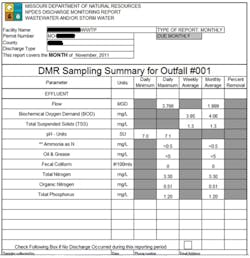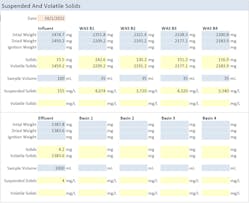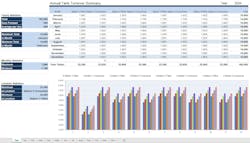Digital Transformation. IIoT. Industry 4.0. While they may seem like just trending buzz words, the technologies are critical to operations being efficient and competitive, and reducing unplanned downtime. Every industry — including water and wastewater — strives for maximum efficiency.
Digital technology and interconnectivity are driving influential technologies like advanced computing solutions; cloud and remote computing; IoT and connected devices; smart and real-time data sensors; data capture, software analytics and processing; and the adoption of artificial intelligence (AI) and machine learning. To remain competitive — particularly in light of worker shortages — and increased productivity, Industry 4.0 and complementary technology must be embraced.
Operators are being asked to do more work than ever before as myriad advanced control features are incorporated for process optimization and improved safety. Additionally, federal and state governments have increased regulatory compliance requirements. Larger forces also create further challenges for wastewater operations — shifting weather patterns, urban population growth, and consolidation of agricultural operations. Fortunately, there are many systems and technologies to aid in overcoming such challenges.
Operations and Technology
The ultimate goal of adopting modern systems is to have a wholly efficient, maybe even an autonomous process that cuts out excess fat, ballooning costs, and wasteful operations. Focus should be on end-to-end process improvement, which will, in turn, help shape collaboration within the organization. That means investing in training and education, process automation, related hardware and new tools or software.[1] Continuous operational improvement starts with capturing data from machine assets. This data provides immediate insights for both people and systems, enabling them to make better, faster decisions and drive automation.
Building next-generation water and wastewater systems requires bold steps to address issues, including leakage, water quality, customer satisfaction, service interruption, and energy savings. The advantages of implementing smart water infrastructure are numerous — from reducing water losses, to improving water quality and supply, to providing more energy and carbon efficient operations. A smart water system can help revolutionize aging infrastructure and how water resources are managed.
Once real-time process information is gathered, the next logical step is to define conditions of concern on those process variables. For example, Are there issues with the flow meters or pressure pumps? Is the effluent flow rater too high or too low? Are chemical storage tanks running low? SCADA systems provide for such conditions to be defined and tracked, monitoring process variables and surfacing active conditions to human machine interfaces (HMI). These condition-based events and alarms add another level to optimizing the process. They allow greater situational awareness for plant operators by calling attention to irregularities and suboptimal scenarios.
Real-time process variables and alarm conditions can then be captured over time, and calculations can be performed to improve planning and offer solutions to detect patterns in the data. Data analysis is especially helpful in detecting early signs of water contamination or equipment malfunction.
Remote Alarm Notification Software
A key theme of Industry 4.0 and smart operations is greater connectivity — increasing connectivity between devices, industrial networks, and physical assets and the cloud. Growing connectivity allows for greater process transparency and the added potential for predictive analytics and sentinel alarm conditions. Smart manufacturing allows potential issues to be addressed before they become problems, but only by extending that connectivity to the final hop. Put another way, it is intended to reach the people who operate and optimize manufacturing assets.
Connecting devices to people and getting the right information — with increased sophistication of modeling — to the right people at the right time is the strength of remote alarm notification software. Remote monitoring and alarm management enables operators to take on more proactive, hands-on tasks in the field or at the plant, without hiring additional staff.
Historic Data and Analytics
The convergence of advanced technologies and data-driven strategies has ushered in a new era of optimization, where historical data analysis plays a pivotal role in achieving accurate forecasting and scheduling. The ability to harness this data effectively can lead to smarter decision-making, improved processes, and a competitive edge. Analyzing historical data allows operations management to identify patterns, trends, and anomalies that may otherwise go unnoticed. These insights serve as the foundation for creating accurate forecasts and efficient operations.[2]
As the past three years have shown, supply chain disruptions and unexpected demand shifts make forecasting more challenging. However, historical data analytics can help water and wastewater plants transition from reactive to proactive planning and keep planning aligned with operations.
Reporting
Reports provide a visualization of this historical process information and correlate related process variables, compute metrics on that data, and visually graph such data for easier pattern and anomaly detection. These reports are created through third-party software that seamlessly integrates with PLCs, SCADA, and historian systems. Advanced reporting solutions can even pull information from remote alarm notification software, allowing further analysis and optimization of condition response times.
Reporting software enables organizations to turn raw process data into actionable information, thereby increasing efficiency and reducing costs. Furthermore, automated reporting solutions streamline regulatory compliance by collecting data from various sources like SCADA, LIMS, manual entry, and others. As the data is collected it is summarized as key metrics, such as flow totals or turbidity threshold analysis. The final output is published into a formatted document accepted by regulatory agencies.
Leveraging aggregated data at the plant level offers economies of scale for managers. With a summation of performance across all machines, larger performance inefficiencies become evident, and managers can develop a deeper understanding of their machine performance, people performance, and process performance.[3]
This data also benefits the entire organization, including billing, customer service, operations, engineering, and distribution, and empowers utilities to address conservation and revenue opportunities.
Alarm Management
A robust alarm management system enhances operational efficiency and enables timely detection of failures. A comprehensive alarm system provides actionable information to the operator and provides assistance in taking corrective action. Research has shown that a well-managed alarm system results in production efficiency and better operator effectiveness.
A poorly managed alarm system creates difficulties for process operators to carry out their duties. They may experience floods of alarm information that obscures critical or abnormal conditions within a collection of many non-critical events. The alarms might be triggered on conditions, which do not have a clearly defined corrective action. In the worst cases, the alarm system can be partially or completely suppressed, leaving them unaware altogether of abnormal conditions. These issues are common in modern, software-based alarm systems, which often contain hundreds or thousands of alarm conditions. This complexity requires a solution that uses statistical analysis to highlight problems and track progress in making improvements.
A cloud-connected alarm management system provides access to real-time alarms even when working remotely to decrease response times and help reduce unplanned downtime. Alarm audits and reporting provide an efficient means to document and track the history of individual alarms, consequences, response time and the action taken to mitigate the alarms. As this rationalization is performed, continued system-level monitoring and assessment reports validate that these efforts are driving real improvement.
Since 1991, alarm management standards have been published and currently the ISA-18.2 and IEC 62682 are the most widely accepted. The standards define a seven-step Alarm Management Cycle program from identification to monitoring and assessment. An effective alarm management program can help the processes get closer to an optimal operating point resulting in lower costs, greater throughput and eventually safer operations.[4]
Continuous Improvement
The fourth industrial revolution, rapid globalization, technological advancements, changing consumer preferences, and evolving government policies are reshaping industries. Trying to meet these challenges with manually intensive processes and outdated technology is difficult. However, by leveraging advanced technology such as real-time alarms and automated processes, operations can increase productivity and efficiency, and reduce costs. Prioritizing operational excellence not only fosters growth but also positions organizations for continued success in an ever-evolving landscape. Improved efficiency is not just beneficial to a utility’s bottom line — it benefits everyone in a community.
Citations
- Megan Ray Nichols, “How Manufacturing Plants Can Prepare for Industry 4.0,” InterestingEngineering.com, April 20, 2018.
- https://www.planettogether.com/blog/analyzing-historical-data-for-enhanced-forecasting-and-scheduling-in-pharmaceutical-manufacturing (accessed November 9, 2023).
- https://www.machinemetrics.com/production-monitoring (accessed November 9, 2023)
- https://www.sciencedirect.com/science/article/abs/pii/S0950423017306320 (accessed November 9, 2023).





